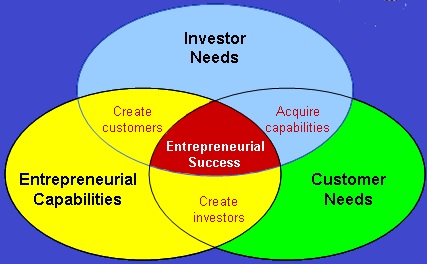- Articles ›
- Entrepreneurship ›
- All About Entrepreneurship - Build Your Dreams Articles
All About Entrepreneurship - Build Your Dreams
I recently came across an article highlighting the increase in the number of start-ups visiting premier campuses like the IITs. These start-ups have the ability to pay fat cheques and are witnessing a rise in the number of applicants wanting to join them. The expertise these firms provide the young enthusiasts will help these budding managers at a later stage to start off their own businesses. While this is one set of students, the other set (excluding the MNC chunk) wants to open its business right away.
This article aims to help out these two sets gain a little insight into the world of Entrepreneurship.
Let’s first answer the question “Who is an Entrepreneur?”
The dictionary definition of an Entrepreneur is “a person who sets up a business or businesses, taking on financial risks in the hope of profit”. This definition is incomplete without words like “craze, passion, hardwork, dedication and decisiveness”. If you strive to become an entrepreneur, these words should describe you.

Image: pixabay
First you must have an idea- a Unique Selling Proposition which you need to put into existence. It starts with the documentation of a business plan. This document describes your plan in great detail. Remember to add the minutest of points.
If the founders are more than one, be clear with the roles and responsibilities. You should divide the equity of the company accordingly. Coming to the monetary part. In the initial stages pitch in your ideas to attract money and later you should target the investors that are established brands. This of course is the most difficult part. A number of business ideas are dropped by the founder at this juncture. Do not give up so soon. If you have faith in your idea, if your team and employees have faith, carry on. Once you have sufficient funds. Keep a track of the outflow and inflow of cash daily. Try to stock money for at least 8-12 months.
During the formative stages you’ll have to be flexible and adaptive. There maybe instances when you have to do something completely different from what you initially thought of. Be ready to change accordingly.
Now, let’s look at the stakeholders one by one and how we should deal with them.
The first would be the investors. These people will give you capital expecting high financial returns. It is all about selling your idea to this lot. If you believe in your idea it will be easier for you to make them believe in the same. One of the most crucial questions that arises at this point of time is “When should one approach them?” The answer to the same is to approach them when you have got your idea into existence. This means that your firm should be in its formative years of establishment but not when you haven’t started. There are two major reasons for this. First, it is very difficult for a person to invest in just an idea. Investors want to know where your firm is heading before making such an important decision. Second, early investment from outside players will lead to an equity dilution which you surely wouldn’t want.
The next in the list of your stakeholders are your employees. They are the most important asset your company possess. To bring these people on board you need to sell them your idea as well. Hire generalist first since they will have to handle a number of departments at the same time. Also make sure that you have sufficient money flow. Remember you will have to pay salaries regularly.
Last but definitely not the least are your customers. To approach them your organisation should first define its brand i.e. any logo or look that will help the audience connect to the product. After this the brand should also have an emotional connect with the audience. Various start-ups are now using social media to reach to its customers.
If you take care of your stakeholders they will take care of you by helping your company grow.
Entrepreneurial Success

http://www.1000advices.com/guru/entrepreneur_byvk.htm
Your company will evolve with the passage of time. Jot down the phases of evolution. This would be the 0 year, 5 year and 10 year plan. For e.g. You should first write down the vision and mission of your company, the market entry plan which you plan to pursue etc. Your 5 year and 10 year plan can concentrate on the growth phase of the company according to the industry type. Remember to use various tools to forecast the customer requirement. This will help you to make a sample profit and loss statement and have a hang as to where your business is heading.
The growth phase of the company will include your new target investors and new customers who will help you take your business to the next level. These groups will not only help you fetch more money, but will also increase the publicity of your firm.
Let us now look at the other side of the coin. Suppose your business fails. What should you do? Is it easy to get back to an MNC? The answer to this can be a plain NO since you now have the expertise of a generalist which are not required by these firms. Here, the assumption I have taken is that you have worked in your venture for a reasonably longer time. If not then it will be much easier for you to get back to a company since you’ll still possess the skills the big wigs require. For those who wouldn’t manage to get back to one of them, there are always reasonably stable start-ups who would like to take you willingly. With so many firms coming up it has become easier for one to find a job. So don’t worry about the future failures and live your dream.
I would like to end my article with the following quote by Tony Gaskins Jr.
“If you don’t build your own dream someone else will hire you to help build theirs.”
This article has been authored by Kanika Bhalla from IIM Rohtak
Views expressed in the article are personal. The articles are for educational & academic purpose only, and have been uploaded by the MBA Skool Team.
If you are interested in writing articles for us, Submit Here
Share this Page on:
What is MBA Skool?About Us
MBA Skool is a Knowledge Resource for Management Students, Aspirants & Professionals.
Business Courses
Quizzes & Skills
Quizzes test your expertise in business and Skill tests evaluate your management traits
All Business Sections
Write for Us